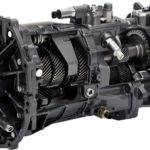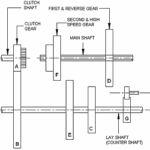Introduction
In an automobile a number of mechanical parts used, which conveys their own vital role to move the vehicle on road. Different mechanisms used for the proper functioning of machine parts and also provides comfort to the driver and take care of machine parts.
The vehicle’s wheel moves with the help of a transmission shaft together with a clutch mechanism. The engine has the capability to produce the power but the power can not be consumed directly by vehicles wheel, so there is a facility of a complete sequence of a mechanism used in a respective manner to transfer the rotational motion from engine to wheels via a transmission system.
The main function of the clutch is to engage or disengage the transmission shafts according to the requirement. It is being placed between the engine shaft and gear shaft (gearbox). During the period of starting, gear changing, and stopping the vehicle, the clutch is used for disengagement.
In the modern automobile industry, various types of clutches used on behalf of the convenience of the vehicle design. In this article, we are concentrated only on single plate clutch type clutch mechanism. As by its name it is clear that it contains only one clutch plate and works on the principle of friction. This type of clutch is divided mainly into two-member, first one is mounted on driver shaft and another one is on the driven shaft. In both of these one shaft is fixed and the other is movable, rotates in axial direction. The fixed shaft allows moving with the help of clutch mechanism in respective manner of splined shaft (movable shaft)
Construction Details
Every mechanism is made of many different parts, so a single plate clutch has also different components. A clutch plate with both side friction lining is the major component of the clutch mechanism. There are some other parts used in a sequential manner and donates the most important role in the function of the clutch. These parts are pressure plate, hub, thrust bearing, springs, cover plates etc.
The clutch system is installed between the flywheel and pressure plate through the hub. The presence of friction lining is important for torque transmission with the help of flywheel and pressure plate. Pressure plate used for pressing the clutch plate which is attached to the flywheel so pressure plate is installed together with spring and flywheel for transmission the input and output motion from the clutch pedal. The driven shaft comes with bearing and lever mechanism.
Main Parts
Single plate clutch has only one clutch plate but there is also some important parts used without which it is impossible to take the output from the clutch mechanism. Most important parts are as follows-
1. Flywheel
Generally every engine consists of a flywheel to store extra energy on accord to the engine capability. The automobile engine has also a flywheel, mounted near the transmission system. The bearing of flywheel is connected with the pressure plate and its motion is as engine crankshaft rotates.
2. Bearing
The bearing is used at the input of the shaft where the crankshaft is mounted. It provides the support to the input shaft and puts the shaft at the center of the disc of the flywheel. It prevents the loss in motion transmission and makes the motion smooth by reducing the friction.
3. Disc plate
This is also known as clutch plate mounted between flywheel and pressure plate. It is the most important part of the clutch system. In a single plate clutch, there is only one disc plate with friction lining on both sides.
Disc plates are made up of asbestos material because they have the property of high heat resistance so disc plate material has a high coefficient of friction. By using the disc plate, damping action can be administrated against torsional vibration.
4. Pressure plate
The pressure plate carries a very important role in a single plate clutch system. On pressure plate, major amount of force is applied so it must have to wear strength. It is made of cast iron so becomes heaviest part in single plate mechanism. Mainly used for maintaining the contact between flywheel and clutch plate. It contains spring for making good surface contact.
5. Clutch cover
This assembly is mounted with the flywheel so it will rotate with respect to the flywheel motion. It has different parts like- release lever mechanism, pressure plate and pressure spring etc.
Also Read:
- What is Cone Clutch and How it Works?
- What is Multi-Plate Clutch – Main Parts, Types and Working
- Centrifugal Clutch – Working Principle, Main Parts Advantages and Disadvantages
Working of Single plate Clutch
- In the working of a clutch system, three basic parts, pressure plate, flywheel, friction plate are employees vital roles. Springs are used for engagement and disengagement of the shafts. To make the shaft engaged during the running of the engine an axial force is required and fulfilled by the springs.
- A flywheel is attached to the engine shaft so it moves similarly as engine movement. The pressure plate is mounted together with the flywheel and follows the flywheel motion.
- When a pressure force is applied through the clutch pedal the pressure plate moves away from friction disc. As a result, the pressure plate becomes disengaged from flywheel and motion transfer interrupted so in disengaged position engine shaft and gear shaft will be free from each other.
- The presence of spring helps to bring back the clutch plates together when pressure force is released, the shafts again come into engaged position and motion transfer continued.
- Engine produces power that is supplied to the crankshaft to the clutch shaft because transmission shaft is further connected with the clutch shaft. By pressing the clutch pedal the pressure plate receives a force and utilise this force in moving against spring force due to which pressure plate and flywheel becomes disconnected and clutch plate becomes free. flywheel shaft will be continuously rotating with engine shaft but clutch shaft slows down.
For Better Understanding Watch the Video:
Advantages
- It facilitates very smooth operation during engagement and disengagement.
- In this type of mechanism power loss is very less.
- as sufficient surface area is available for heat dissipation therefore no cooling oil is required.
- This is also known as a dry clutch plate.
- It has a very quick operation and response time is fast.
Disadvantages
- It has high wear and tear rate.
- Torque transmitting capacity is not really good.
- The spring has to be the more stiff hence greater force required for disengagement.
- High maintenance is required.
- For installation, this mechanism required more space than other types of clutches.
Application
This type of clutch is used mainly in cars, buses, and trucks. Single plate clutch cannot be used in two-wheelers because there is not sufficient space as required by a single plate clutch, so it can be used only where large radial space is available.








